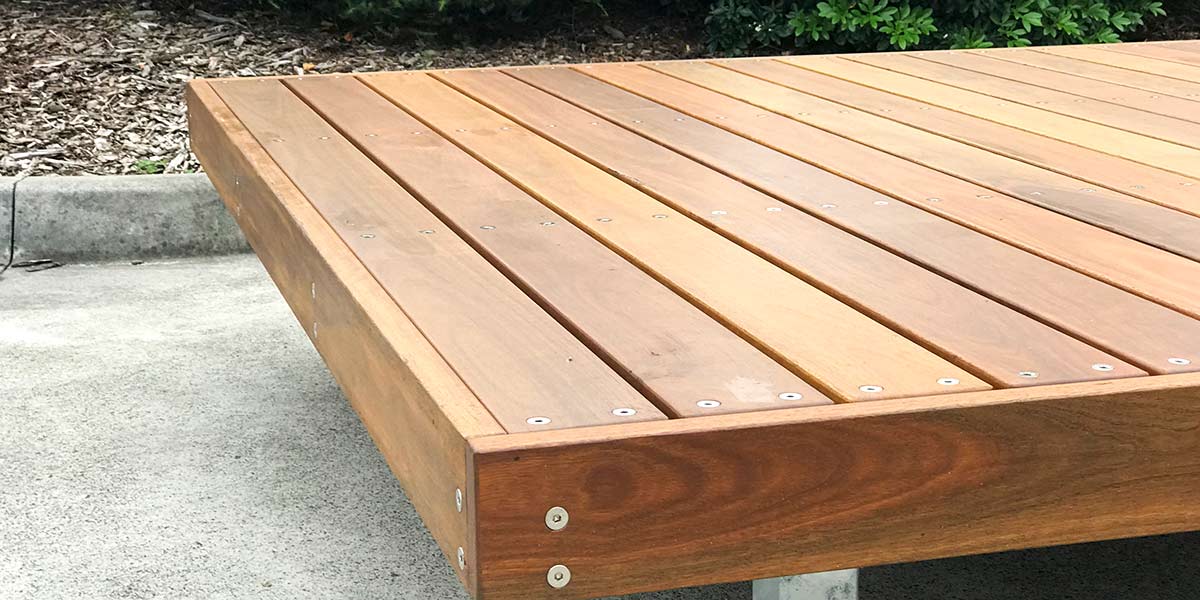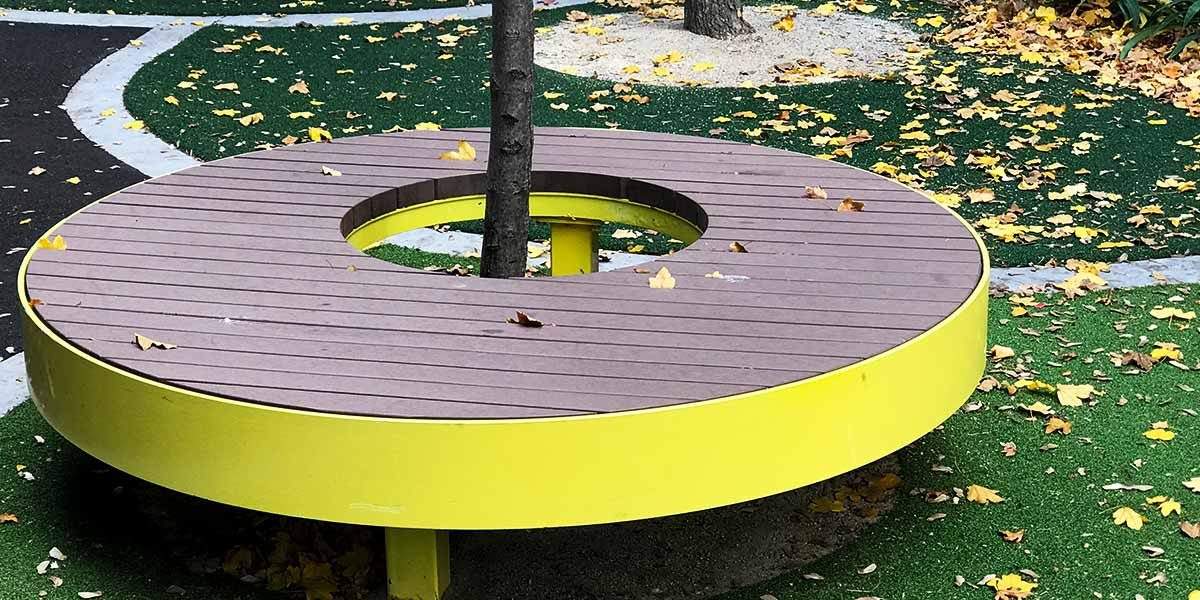
The vast majority of street furniture utilises a frame and batten style design (eg. cast aluminium frame set with timber battens). Most street furniture suppliers have an array of options in this regard, with each material having its own advantages and disadvantages. These fall into the following categories:
- Durability
- Strength
- Aesthetic Value (subjective/personal)
- Cost
- Environmental Impact/Sustainability
- Availability
- Maintenance Requirements
In this Tech Note, we will hopefully be able to share some of our experience to make it easier for you to choose the best material and finish for your project.
Timber Battens for Street Furniture
Contrary to a lot of popular opinion, timber is a very sustainable material to use, if it is sourced from a sustainable plantation. The act of using timber creates a static store of carbon, as long the tree is replaced when harvested then more carbon is now in solid form rather than C02 in our atmosphere. There is also opinion that the production process of growing and harvesting timber produces less C02 than other materials, ie Aluminium, Composites.
Spotted Gum (Lemon-scented Gum, Spotted Irongum, Eucalyptus maculata, Corymbia citriodora, Eucalyptus citriodora, Corymbia henryi, and Eucalyptus henryi).
A very common form of Eucalypt that typically grows along Australia’s east coast, from northeast Victoria to the northern tablelands of Queensland. ‘Spotted’ refers to the mottled colour of the wood that appears as the tree sheds strips of bark. Generally grown in sustainably operated plantations, spotted gum is often favoured for its durability and wavy grain characteristics that produce an attractive ripple effect.
Pros
- Sustainably produced
- Very dense
- Timber characteristics
- Highly durable for outdoor applications
- Strong, long spans between supports
- Readily available
Cons
- Prone to Splitting and Cracking
- Inconsistent Colour and Grain
- Prone to Gum Vein
Blackbutt (Coastal Blackbutt, Pink Blackbutt)
Generally grown in sustainable plantations in Australia, Blackbutt is a very dense timber that is becoming quite popular among municipalities due to its sustainability and durability. Named after the the trees appearance after bushfire, Blackbutt’s quick growth and versatility makes it a good plantation timber. The even texture and generally straight grain makes it a popular choice for outdoor furniture.
Pros
- Sustainably Produced
- Very Dense
- Character
- Highly Durable for outdoor applications
- Strong, long spans between supports
- Readily Available
Cons
- Prone to Splitting and Cracking
- Inconsistent Colour and Grain
- Prone to Gum Vein
Treated Pine
Pine is a softwood found throughout Victoria, western NSW and central western Queensland. It has a generally straight grain with a fine, even texture but numerous tight knots throughout the timber are common.
Pros
- Sustainably Produced
- Consistent Colour
- Cheap
- Readily Available
- Easy to Machine
Cons
- Soft
- Needs treating to make it suitable for outdoor use
Timber Finishes
No Finish
Durable hardwoods can be left untreated and can do quite well in open spaces. The timber will tend to go grey within 12 months, and may crack and splinter more than if coated, but will generally last a long time in this state. Among councils there is an increasing trend towards leaving timber uncoated. This frees them of the need to maintain the finish (which may not have been done anyway). It has also become vogue in some applications, particularly in conjunction within Stainless Steel.
Quantum/Cutek Style Stains
Water soluble, non toxic, non flammable, deep penetrating commercial timber finishes. Generally tinted and can be re-coated/repaired on site with brush.
Pros
- Cost Effective
- Natural Look
- Easy Application
- Low Environmental Impact
Cons
- Requires recoat every twelve months
2 Pak/Polyurethane/Marine Clears
By using a hard clear coating that sits on the surface of timber like glass, you can achieve a look that is stunning. However, the number one downside is that they tend not to stand up in areas where you find street furniture. Because they are clear, they are prone to be broken down by UV, and because they are hard, they will crack and become opaque as timber moves with temperature/humidity. There are different systems that work to varying degrees, but in general it is wise to steer clear of any clear coating on timber that dries hard on the surface for outdoor use.
Pros
- Beautiful Finish
- Hard Wearing
- Protects Timber
Cons
- Breaks Down in environment
- Expensive Process
- Generally not environmentally friendly
- Difficult to apply
- Toxic chemicals
Timber Alternatives
Composite Battens
There are now a variety of different composite battens available, offering a wide range of textures and colours to replace the use of timber. Most of these products use a mixture of recycled plastic and recycled timber waste, bonded together with some virgin materials and glues. Marketed mainly for its environmental benefits, there is some who would argue that the production process, shipping, power, virgin materials and chemicals make it no more environmentally friendly than sustainable timber. However composites do have other advantages, such as no ongoing maintenance, and uniform finish.
Recycled Plastic
Made from almost 100% recycled plastic, the main benefits are the sustainability and the lack of maintenance required. A large variety of batten sizes are available, and the product is reasonably priced. However, size for size the product is far weaker than timber, so either much larger sections need to be used, or more supports. This makes it impractical for some designs.
Pros
- Sustainability
- Variety of Colours available
- Zero Maintenance
- When large sections used very hardy
Cons
- Weak, needs more support than same sized timber
- Can sag in sun
- Can add cost to furniture if more supports are required than timber
Anodised Aluminium
Light, strong, low maintenance, economical; aluminium is a great material for many applications. Finish and section properties are always constant and free from imperfections. Aluminium profiles can span large distances making it possible to work with less framing which reduces cost. The big downside of aluminium is the environmental impact, both in the extremely high use of electricity to initially manufacture, and the release of perfluorocarbons. Aluminium is 100% recyclable however, and only uses 15% of the energy to recycle the material into another product.
Pros
- Consistent
- Economical
- Durable
- Maintenance Free
- Large Spans
Cons
- Environmental impact
- Clinical look that doesn’t suit all applications
If you have and questions or need advice when specifying a batten material please contact one of our friendly engineers. We love to put our experience and resources to work helping solve our customer’s problems.



